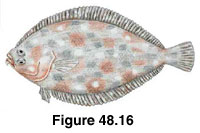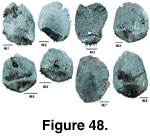 Description
DescriptionCitharichthys stigmaeus (Speckled
Sanddab)
(Other common names: Catalina sand dab)
Figure 48.16
 Description
DescriptionLength: 15 cm.
Mouth: moderate, terminal; jaws symmetrical; median knob on tip of lower jaw; maxillary extends to from on lower eye; snout is shorter than the length of the lower eye.
Body: head is deep and blunt; left pectoral fin shorter than head; caudal peduncle slender; caudal fin rounded; ridge around lower eye absent; lateral line straight.
Color: olive brown with black speckles; creamy on blind side; young can be gray with black speckles.
Depth: up to 550 m (usually shallower).
Habitat: sandy substrates; from nearshore to deep.
Season: spawning occurs in winter month with larvae appearing in the spring and summer; spawning takes place in shallow water.
Diet: small crustaceans (e.g., amphipods, copepods), polychaetes.
Predators: fish, marine mammals, sea birds.
Distribution: Mexico to Alaska.
 Scale
Description
Scale
DescriptionRelative Scale Size: moderate to large.
Position of Scales on Body: on lateral line canal; 52-58 scales; imbricated pattern; deciduous; ctenoid on both sides of body (Hart, 1973).
Overall Shape: both ctenoid and cycloid scales are circular; ctenoid pattern is weak.
Focus and Circuli: the focus abuts the region of ctenoid growth and is approximately one-tenth of the total length of from the posterior field's outer edge. The posterior field is short and the anterior field is wider than the lateral fields are long. The circuli are tightly compacted and generally continuous between the lateral and anterior fields. They appear to truncate at the ctenoid interface. Regeneration appears common. The outer edge of the anterior field is scalloped.
Radii: radii not present in all fields; intermarkings present and are uniform in lateral and anterior field (Batts, 1964).